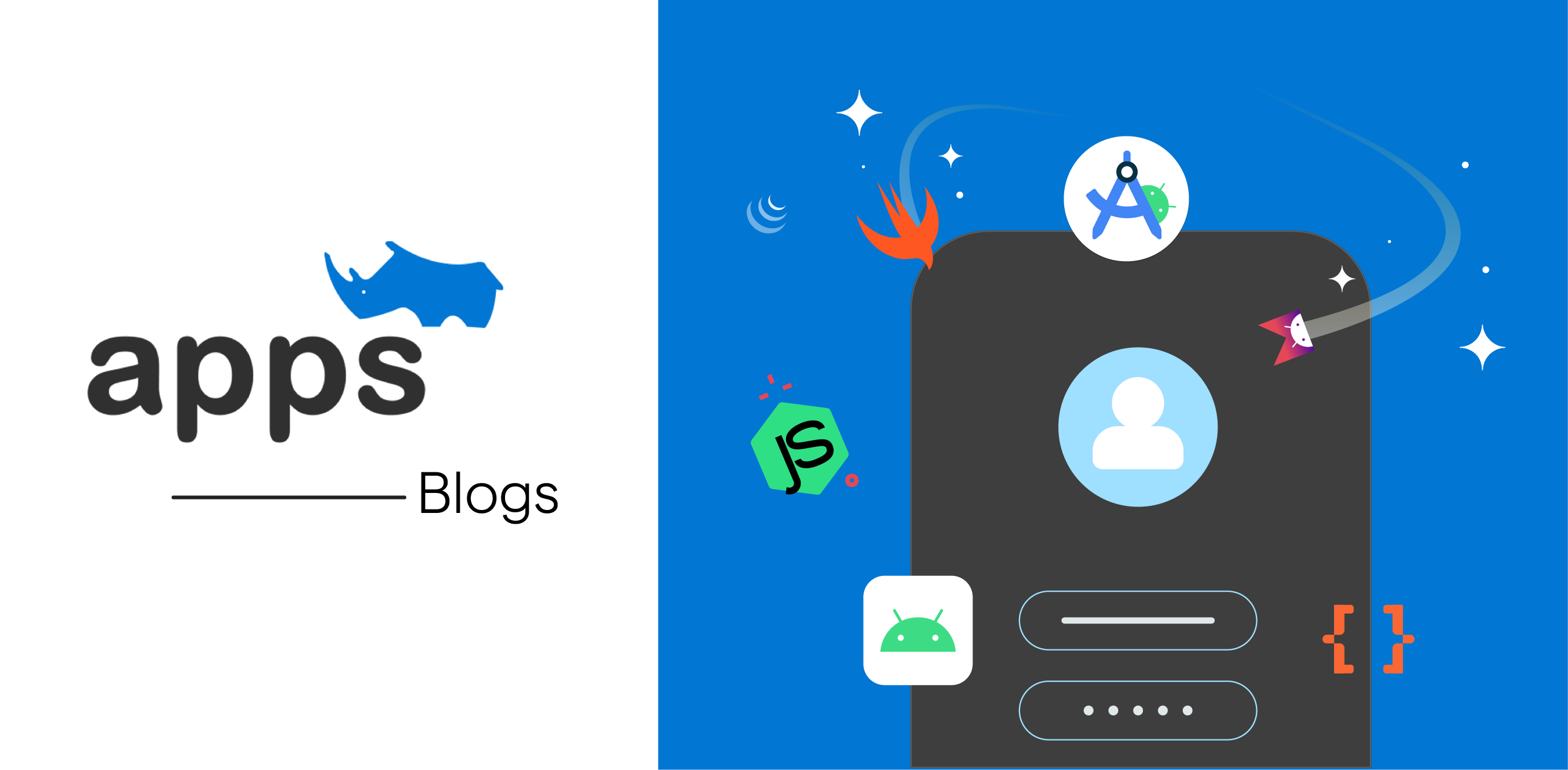- What is Electronic Prescribing Software?
- Why Electronic Prescribing is Important in 2025?
- Benefits of Using Electronic Prescribing Software
- Examples of Successful Electronic Prescribing Adoption
- Problems With Manual Prescribing in 2025
- How to Choose the Right Electronic Prescribing Software
- Future of Electronic Prescribing
- Conclusion
- Frequently Asked Questions (FAQs)
Table of Contents
Why Electronic Prescribing Software Is a Must in 2025
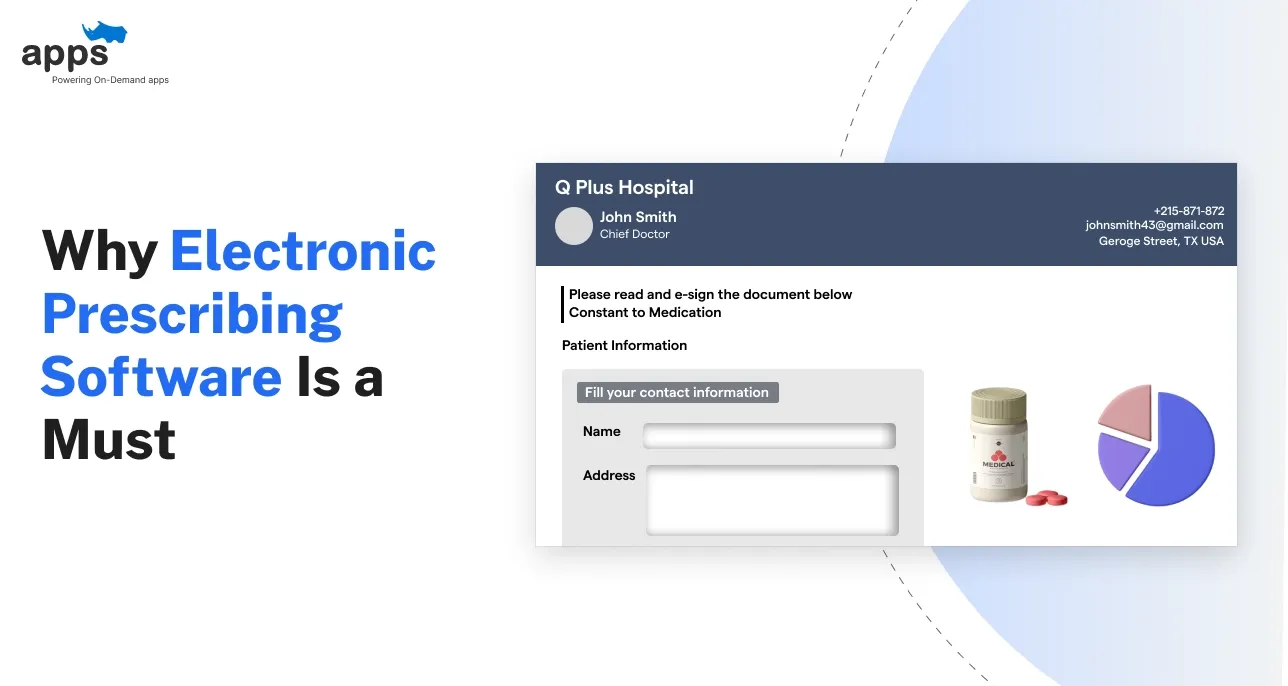
If your practice isn’t prescribing electronically yet, you’re already behind.
Today’s healthcare system moves faster than ever, but outdated manual prescriptions slow everything down. Doctors face endless paperwork, pharmacies deal with errors, and patients wait longer for the necessary care. It’s frustrating for everyone involved.
As 2025 unfolds, we’re hitting a tipping point. Healthcare providers can no longer afford to rely on manual processes. The solution is straightforward- electronic prescribing software. It emerges as the essential solution, offering a streamlined, secure, and efficient approach to meet these evolving demands.
We're here to walk you through why moving to electronic prescribing software today isn't just a good decision, it's necessary to remain ahead.
Let’s dive in!
What is Electronic Prescribing Software?
Electronic prescribing software is a digital tool that lets doctors send prescriptions straight to a patient’s pharmacy.
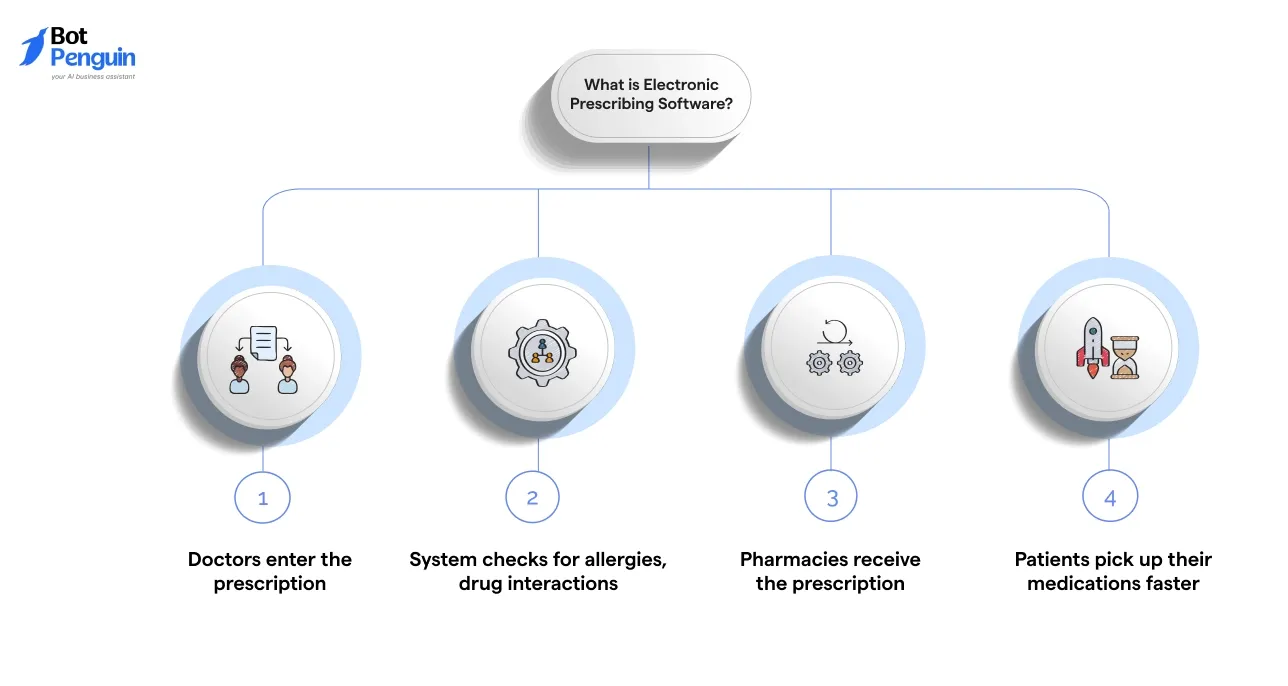
No paper, no faxing, no messy handwriting. Just quick, secure, and direct communication between healthcare providers and pharmacists.
Here’s how electronic prescribing software works:
- Doctors enter the prescription directly into a secure system.
- The system checks for allergies, drug interactions, and dosage mistakes.
- Pharmacies receive the prescription electronically with no chance of errors.
- Patients pick up their medications faster without needing a paper copy.
Some platforms even offer electronic prescribing software for free as part of larger digital health packages, helping smaller clinics upgrade without high costs
In 2025, electronic prescribing software is a must-have modern upgrade. It connects doctors, pharmacists, and patients effortlessly, making healthcare safer, quicker, and more efficient.
Why Electronic Prescribing is Important in 2025?
The way healthcare works is changing faster than ever. Manual prescriptions are becoming a major roadblock instead of a helpful tool.
Patients, providers, and pharmacies all expect faster, safer service, and electronic prescribing software delivers it.
There’s never been a more important time to switch to electronic prescribing software; here’s why:
Changes in Healthcare Practices
Doctors are seeing more patients remotely and need faster ways to send prescriptions without in-person visits.
Government Rules and Digital Health Policies
New regulations now push healthcare providers to use secure, digital systems for patient data and prescriptions.
Patient Expectations for Faster Service
Patients are used to getting everything quickly and they expect the same speed and accuracy from their healthcare providers.
Pressure to Improve Patient Safety
Manual errors in prescriptions can cause harmful mistakes. Digital systems double-check dosages and drug interactions automatically.
Need for Better Coordination
Doctors, pharmacies, and insurance companies need to communicate instantly. Electronic systems keep everyone in sync.
Without electronic prescribing software, healthcare providers risk falling behind both in service quality and in meeting legal standards. Some may even lose patients who prefer faster, digital-first care.
Choosing the right system now, whether it’s a premium solution or electronic prescribing software free, means staying ahead in a competitive and fast-changing healthcare world.
Benefits of Using Electronic Prescribing Software
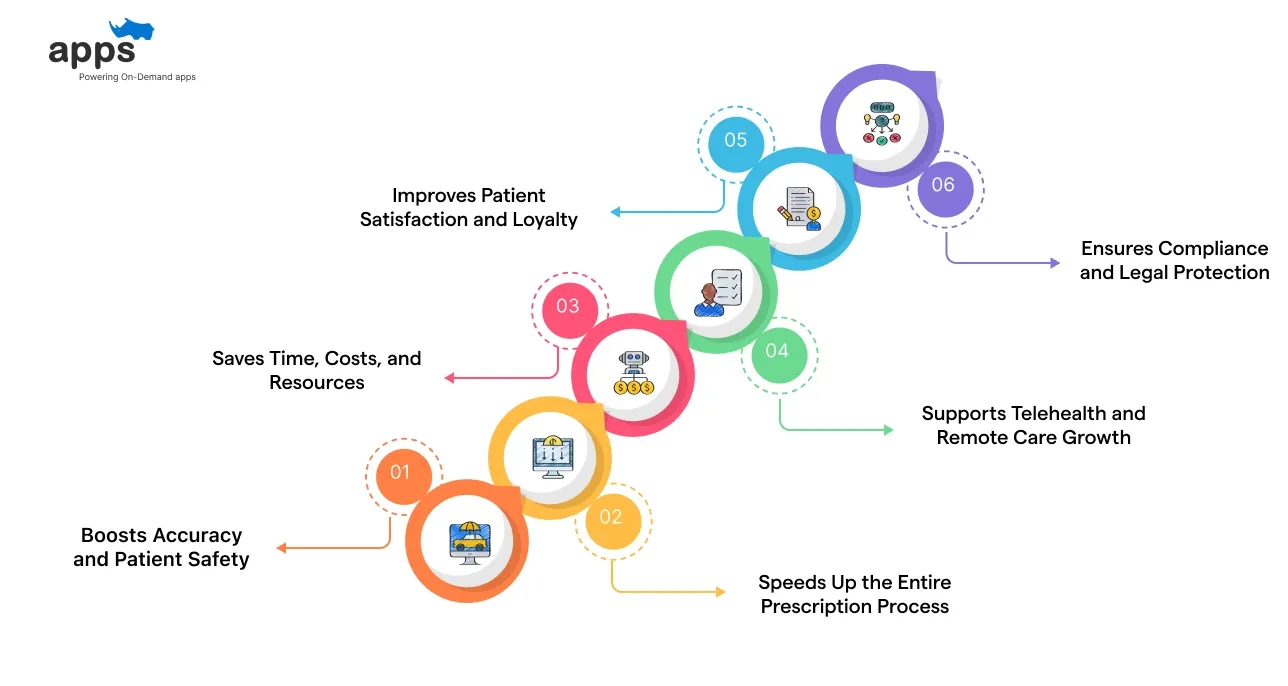
Using electronic prescribing software in 2025 gives healthcare providers a significant advantage.
It saves time, boosts safety, cuts costs, and improves patient satisfaction, all while meeting the growing demands of modern digital health standards
Here’s how it helps:
1. Boosts Accuracy and Patient Safety
- No more struggling to read messy handwriting.
- Automatic alerts for drug allergies, dangerous interactions, and dosage mistakes.
- Clear, direct communication between doctors, pharmacies, and insurers.
- Built-in patient data checks lower the risk of life-threatening prescription errors.
- Digital audit trails ensure transparency and accountability.
2. Speeds Up the Entire Prescription Process
- Prescriptions are transmitted instantly to the pharmacy.
- Patients get their medications faster without long waits.
- Doctors spend far less time filling out and correcting paperwork.
- Refills can be authorized with just a few clicks instead of lengthy calls.
- Seamless service resulting in happier patients and a smoother workflow.
3. Saves Time, Costs, and Resources
- Cuts down manual tasks like faxing, calling pharmacies, and storing paperwork.
- Meets insurance billing and regulatory requirements automatically.
- Reduces physical printing, filing cabinets, and administrative staff hours
- Streamlines renewals and refills with just a few clicks..
- Electronic prescribing software free offers massive savings over time.
4. Supports Telehealth and Remote Care Growth
- Doctors can prescribe medications instantly during virtual visits.
- Patients can receive their prescriptions without setting foot in a clinic.
- Full medication histories are available 24/7 for better treatment decisions.
- Secure e-prescribing ensures safe remote care without paperwork delays.
- Easily integrates with telehealth platforms for a seamless care experience.
5. Improves Patient Satisfaction and Loyalty
- Patients appreciate faster service, fewer errors, and easy access to medications.
- Better communication builds confidence and trust in your practice.
- Easy refill requests and real-time prescription tracking improve patient experience.
- Digital prescriptions reduce wait times at the pharmacy, adding convenience.
- Modern, tech-enabled care meets rising patient expectations in 2025.
6. Ensures Compliance and Legal Protection
- Built-in support for HIPAA, EPCS, and national drug-monitoring programs.
- Automatic documentation keeps your clinic ready for audits and inspections.
- Reduces the legal risks linked to manual prescription errors.
- Tracks controlled substances to prevent misuse and ensure accountability.
- Real-time updates help you stay aligned with changing healthcare regulations.
By switching now to electronic prescribing software, whether a premium platform or free electronic prescribing software, providers stay ahead of legal requirements, deliver better care, and create more efficient, future-ready healthcare operations.
Examples of Successful Electronic Prescribing Adoption
Across the world, healthcare organizations are seeing huge benefits after switching to electronic prescribing software. Real improvements are happening every day for doctors, pharmacists, and patients.
Hospitals, clinics, and pharmacies have seen major gains with electronic prescribing. Hospitals report fewer prescription errors, while clinics experience faster patient turnaround and improved satisfaction. Pharmacies benefit from smoother workflows and fewer clarification calls.
Most importantly, patients are noticing the difference. The convenience of digital prescriptions, sent directly to pharmacies, reduces wait times and boosts trust in healthcare providers.
1. Veterans Health Administration (VHA)
The U.S. Department of Veterans Affairs adopted VistA (The Veterans Health Information Systems and Technology Architecture), an advanced electronic health record system with integrated e-prescribing.
This allowed healthcare providers to manage prescriptions digitally, improving accuracy and reducing errors.
As a result, the VA achieved a prescription accuracy rate of 99.997%. This transformation boosted patient safety and greatly enhanced operational efficiency across its nationwide network of facilities.
2. Surescripts Network

A study by Surescripts demonstrated that e-prescribing led to a 10% increase in first-fill medication adherence among patients.
By facilitating direct electronic communication between prescribers and pharmacies, e-prescribing reduced prescription errors and enhanced the likelihood of patients obtaining their medications promptly.
The study estimated that widespread adoption of e-prescribing could lead to healthcare savings ranging from $140 billion to $240 billion over a decade, primarily through improved medication adherence and reduced adverse drug events.
3. PrescribeIT® in Canada
PrescribeIT®, Canada's national e-prescribing service, enables prescribers to send prescriptions directly to a patient's pharmacy of choice.
A case study focusing on primary care providers revealed that PrescribeIT® improved the efficiency of prescription transmission, reduced the reliance on faxed prescriptions, and enhanced the accuracy of medication records.
Healthcare providers reported increased satisfaction due to the system's ability to facilitate seamless communication between prescribers and pharmacists.
These case studies underscore the tangible benefits of adopting electronic prescribing systems, including enhanced patient safety, improved medication adherence, streamlined workflows, and significant cost savings.
As healthcare continues to evolve, embracing e-prescribing is a critical step toward delivering high-quality, efficient, and patient-centered care.
Problems With Manual Prescribing in 2025
In 2025, sticking to manual prescribing creates more problems than ever. It puts doctors, clinics, and patients at risk and slows care when speed matters most.
Why manual prescribing is no longer safe:
1. Risk of Errors
- Handwritten prescriptions are often misread, leading to serious medical mistakes.
- Misspelled or unclear drug names increase the risk of harmful medication errors.
- No built-in alerts for allergies, interactions, or incorrect dosages in manual systems.
2. Delays in Patient Care
- Patients must hand-carry paper prescriptions, adding unnecessary delays.
- Pharmacy confusion slows down medication delivery, risking missed or late doses.
- Doctors waste time clarifying prescriptions instead of treating patients.
3. Legal and Compliance Risks
- Manual processes lack the automatic checks required by digital health policies.
- Not complying with prescribing laws can result in heavy penalties or lawsuits.
- Poor documentation makes it difficult to defend against legal claims or audits.
4. Losing Patient Trust
- Delays and errors make patients lose confidence in your clinic’s reliability.
- Losing prescriptions shows disorganization and unprofessionalism to patients.
- Paper scripts feel outdated and inefficient in the modern era.
5. Increased Administrative Burden
- Staff spend hours filing and chasing down prescription issues manually.
- Manual work reduces time available for meaningful patient interaction.
- Increased paperwork creates stress and lowers productivity across the clinic.
6. Security Risks and Data Loss
- Paper scripts can be easily lost, stolen, or damaged beyond recovery.
- Physical records are harder to track, encrypt, and protect from misuse.
- Without digital backups, data loss risks increase during emergencies or errors.
In a world where patients can do almost everything online, manual prescribing feels outdated and frustrating. Switching to electronic prescribing software is the best way to protect your practice and your patients from avoidable mistakes.
How to Choose the Right Electronic Prescribing Software
In 2025, selecting the ideal electronic prescribing software is a game-changer. With hundreds of options available, identifying the right partner can mean the difference between a seamless success and a daily hassle.
Here's how to pick wisely and safeguard your practice's future.
Key Features to Look For
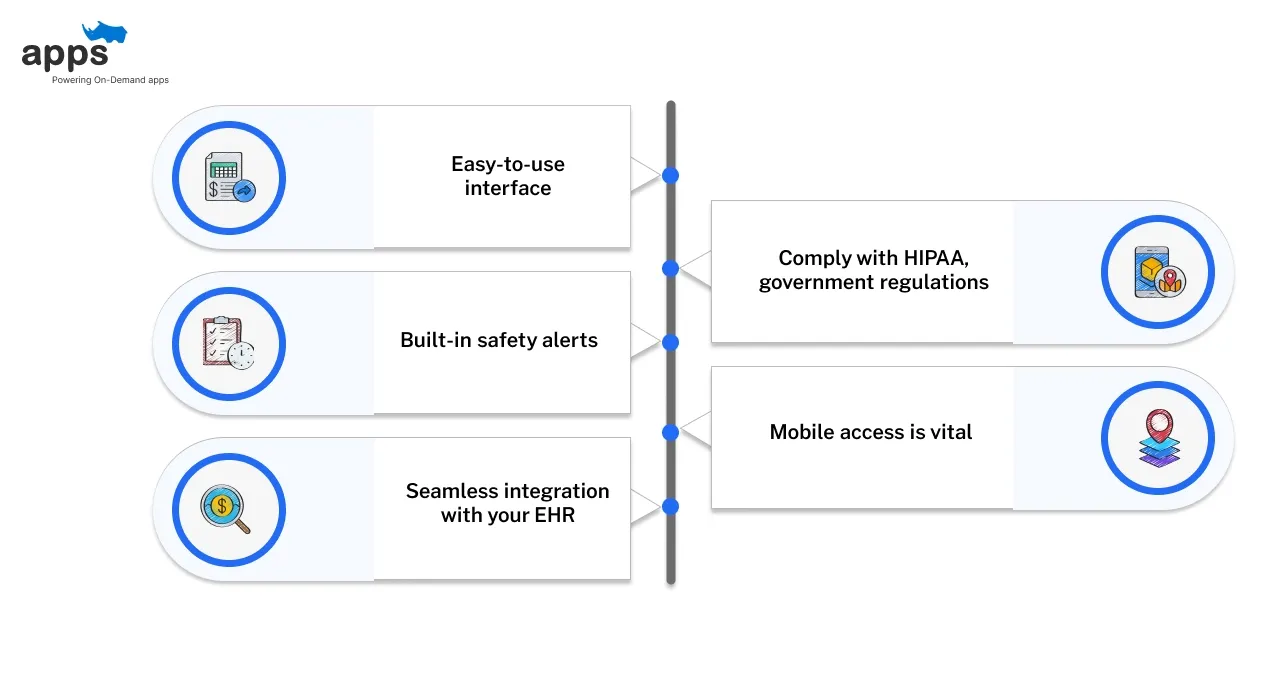
- Easy-to-use interface that your team can learn quickly without complex training.
- Built-in safety alerts for drug interactions, allergies, and dosage conflicts.
- Seamless integration with your EHR or practice management system is essential.
- Must comply with HIPAA, government regulations, and insurance billing needs.
- Mobile access is vital; choose a platform that supports prescribing on the go.
Questions to Ask Before Buying
- Does it support EPCS for prescribing controlled substances securely and legally?
- Is there a free trial or an electronic prescribing software free version available?
- How often are updates, bug fixes, and security patches released?
- Can it scale smoothly as your practice grows or expands?
- Is customer support available for setup, training, and technical issues?
Tips for Easy Setup and Staff Training
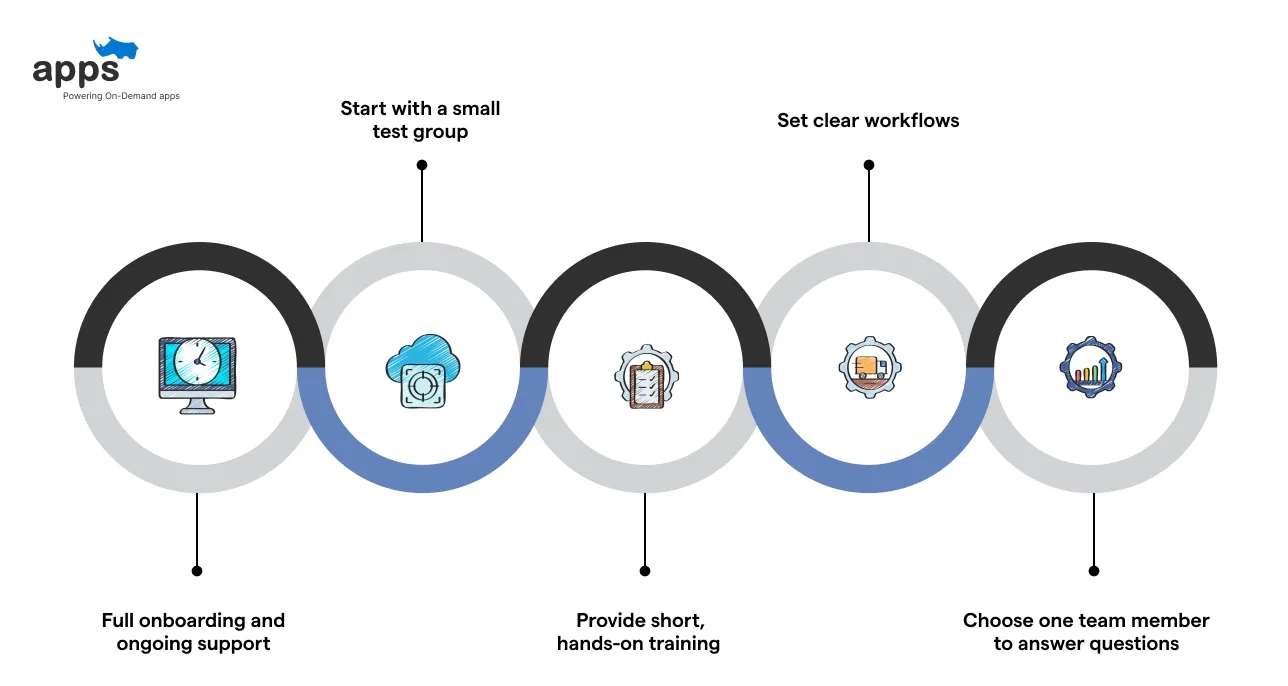
- Pick a vendor that offers full onboarding and ongoing support.
- Start with a small test group before rolling out practice-wide.
- Provide short, hands-on training sessions to build staff confidence quickly.
- Set clear workflows so everyone understands how to use the software.
- Choose one team member to answer questions and help with the transition.
Searching for a More Intelligent Electronic Prescribing Software?
Healthcare providers need e-prescription software that’s fast, secure, and connected.
It should be easy to use, update in real time, integrate with existing systems, and support remote care.
All of these requirements are possible with a custom E-prescription software build with your business needs in mind.
AppsRhino specializes in developing custom healthcare applications that align with industry demands:
- Healthcare Data Integration: Access to lab results and patient histories.
- Regulatory Compliance: Adheres to HIPAA, GDPR, and SaMD standards
- AI-Powered Diagnostics: AI suggests treatments and flags drug risks.
- Seamless Integration: Integration with EHRs, labs, and billing systems.
- Comprehensive Support: Complete help from launch to ongoing updates.
Choosing the right electronic prescribing software now will deliver genuine efficiency benefits, take your patient care to new levels, and help you to avoid costly headaches later.
Future of Electronic Prescribing
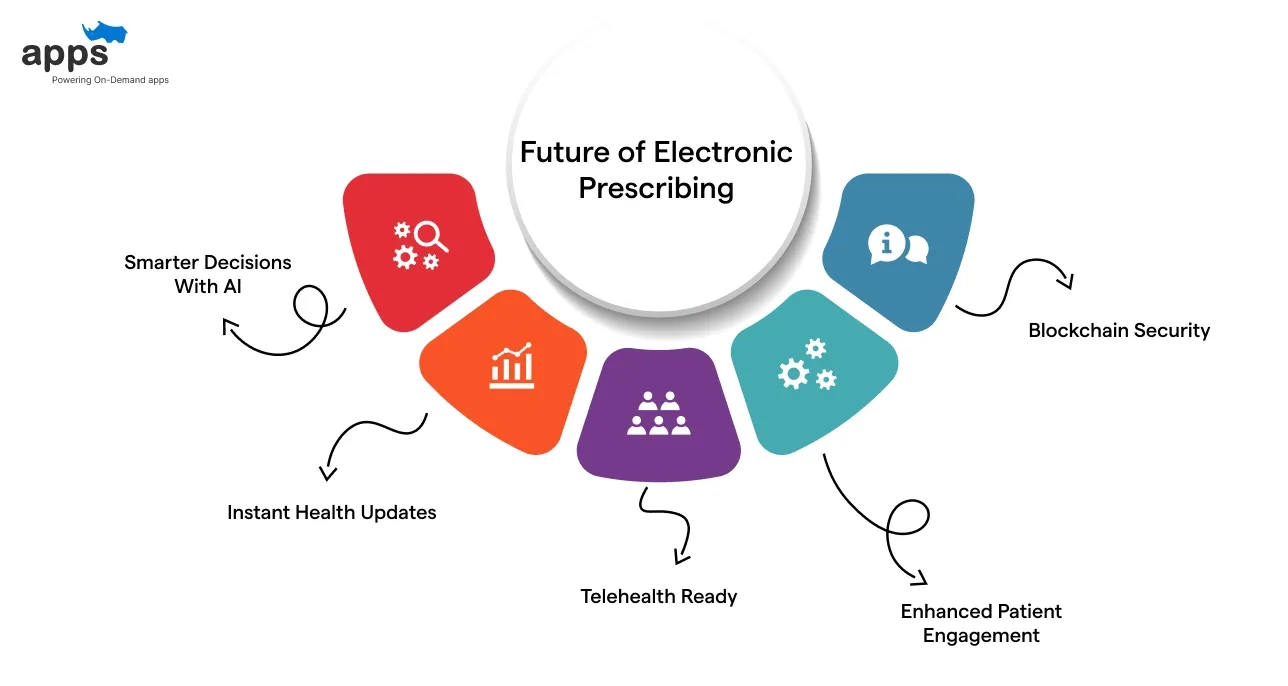
The future of healthcare is digital, and electronic prescribing software is at the forefront of this transformation. Here's what to expect:
Smarter Decisions With AI: AI will help doctors choose safer, more personalized treatments by flagging drug interactions.
Instant Health Updates: E-prescribing will sync with health records to adjust based on real-time patient data.
Telehealth Ready: Doctors will prescribe meds directly during video visits, no in-person trip needed.
Enhanced Patient Engagement: Mobile apps will remind patients to track prescriptions, receive refill reminders, and access dosage instructions.
Blockchain Security: The adoption of blockchain technology will ensure prescriptions are tamper-proof.
Embracing electronic prescribing software, including electronic prescribing software free options, positions healthcare providers to deliver safer, more efficient, and patient-centric care in the evolving digital landscape.
Conclusion
The world of healthcare is evolving, and so are the tools we need to keep up. Electronic prescribing software is no longer just a convenience; it’s a necessity in 2025.
In fact, the global e-prescribing market is projected to grow from $1.2 billion in 2020 to $3.3 billion by 2025 (MarketsandMarkets). This rapid growth clearly shows how essential it is for providers to stay current and competitive.
Manual prescribing slows service, increases errors, and risks legal issues and lost patient trust. Going digital means faster prescriptions, better care, stronger compliance, and smoother operations
Future-proof your practice TODAY. Choose electronic prescribing software and lead the way in safer, smarter healthcare for the future!
Frequently Asked Questions (FAQs)
Why is 2025 considered a tipping point for electronic prescribing software?
New regulations, rising patient expectations, and digital health policies risk manual prescribing. 2025 is when staying compliant and competitive demands going digital.
How can a practice start using electronic prescribing software without overwhelming the staff?
Start with a small group, offer hands-on training, and choose software with great support. Clear workflows ease the transition.
Are there any affordable or free electronic prescribing options to test before fully investing?
Yes, many vendors offer a free trial or an electronic prescribing software free version. Just ensure it meets HIPAA and EPCS standards.
What happens if a clinic continues manual prescribing in 2025?
Manual prescribing risks more errors, legal penalties, and patient dissatisfaction. It’s outdated and risky in today’s fast-paced digital healthcare.
How will AI and telehealth make electronic prescribing even better in the future?
AI will help doctors choose safer meds, while telehealth enables instant, remote prescribing. It’s smarter, faster care.
Can small clinics and solo practices benefit from electronic prescribing software, too?
They gain efficiency, reduce errors, and improve care, often with low-cost or electronic prescribing software free versions tailored for them.
Table of Contents
- What is Electronic Prescribing Software?
- Why Electronic Prescribing is Important in 2025?
- Benefits of Using Electronic Prescribing Software
- Examples of Successful Electronic Prescribing Adoption
- Problems With Manual Prescribing in 2025
- How to Choose the Right Electronic Prescribing Software
- Future of Electronic Prescribing
- Conclusion
- Frequently Asked Questions (FAQs)


